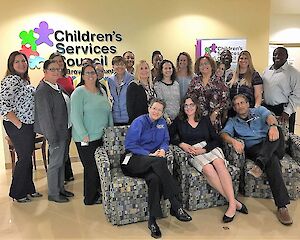My Approach
My work focuses on bringing cognitive and social science to bear on communication strategies for social and public health problems. I have designed and analyzed research investigating public understanding of a host of social issues – including child and youth development, mental health and addiction, racial and economic equity – and designed and tested messages that improve understanding and support for policy. The bulk of my applied work is translating evidence from social science into concrete strategies and tools that help communicators understand and navigate several layers of challenges, including:

Lynn with Staff of the Children's Services Council of Broward County, Florida
- Non-experts’ typical patterns of reasoning about social problems;
- Dominant frames on issues found in our public discourse; and
- Inherited messaging from previous efforts, campaigns or organizational eras.
My approach is grounded in the belief that far too often in issue communications, messaging strategies are ad-hoc or reactive, and are driven by scant research. In the end, they fail to improve public understanding of complex social problems.
The goal of my consultancy is to provide organizations with an evidence-based messaging infrastructure for their work. I work with organizations that have defined policy agendas or programmatic initiatives and the staff and leadership support within their communications profiles to implement recommendations from framing science. That can be accomplished in a number of ways, but the general scope of work that I engage in comprises the following:
- A framing analysis of current messaging in existing public-facing communication materials.
- Intensive trainings for front-line communicators in the science of communications for social change.
- Ongoing, hands-on coaching and technical assistance to staff and stakeholders on messaging challenges and needs as they arise.
- Development of a core messaging strategy and other relevant collateral, such as messaging toolkits.